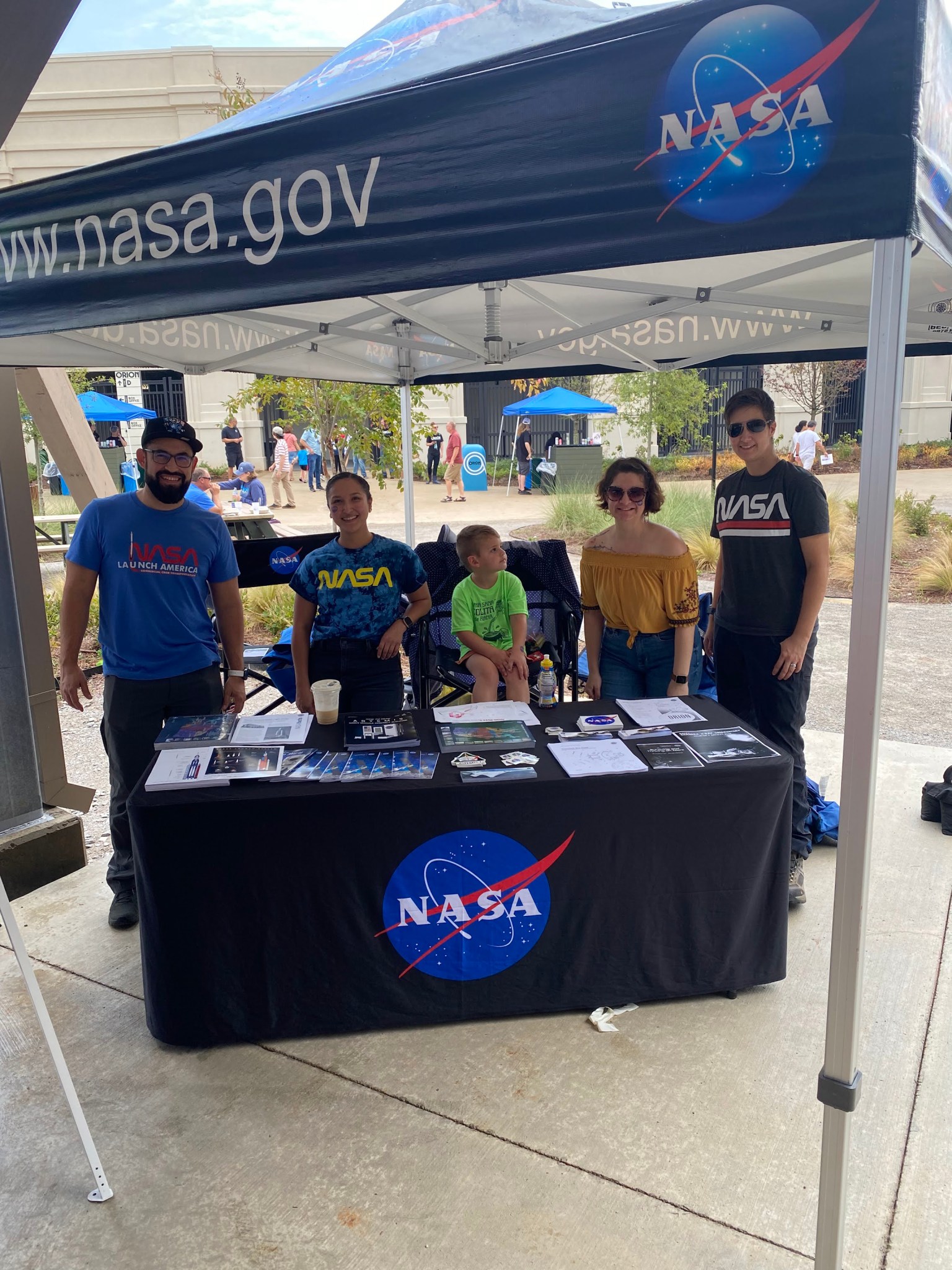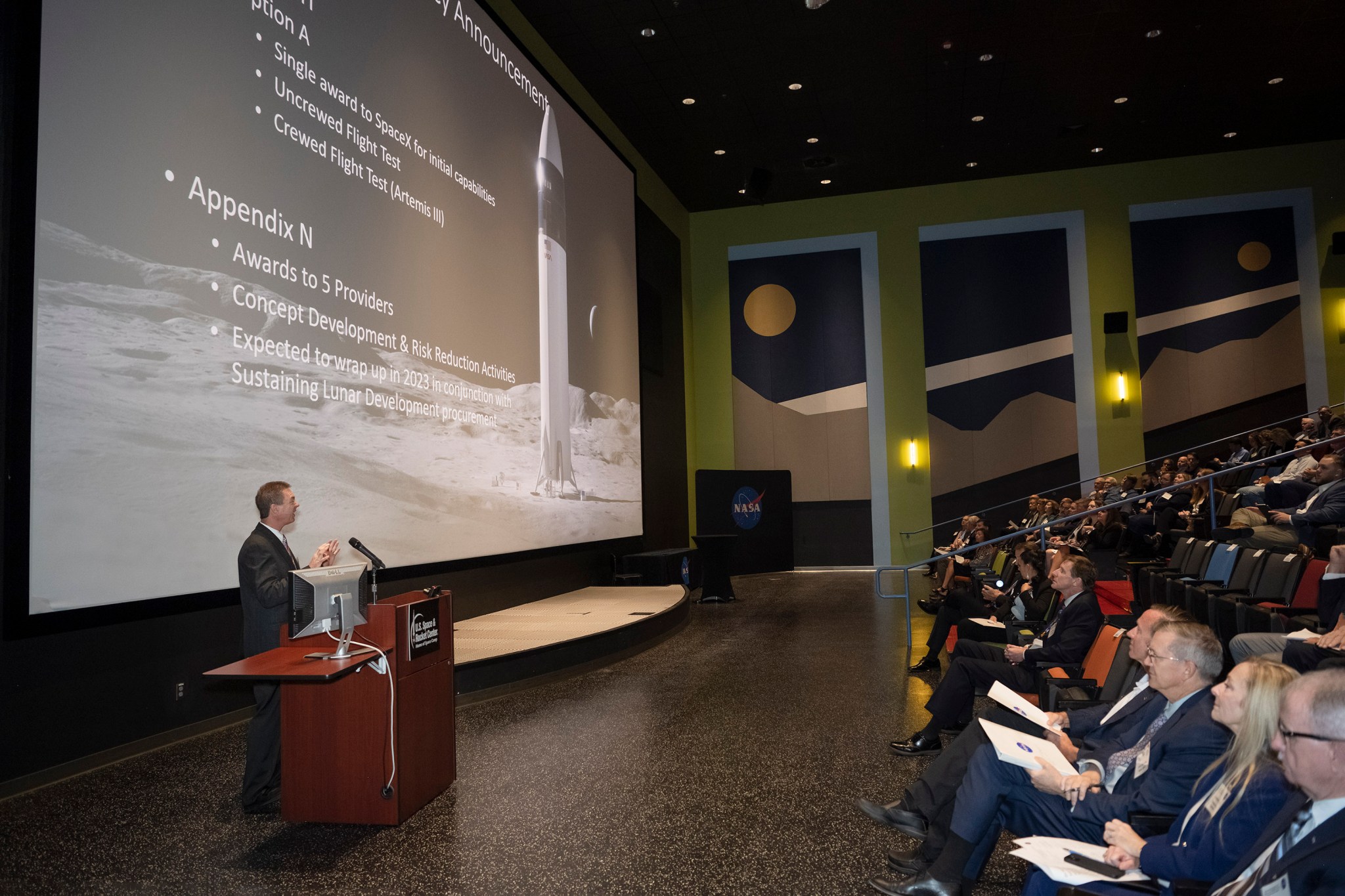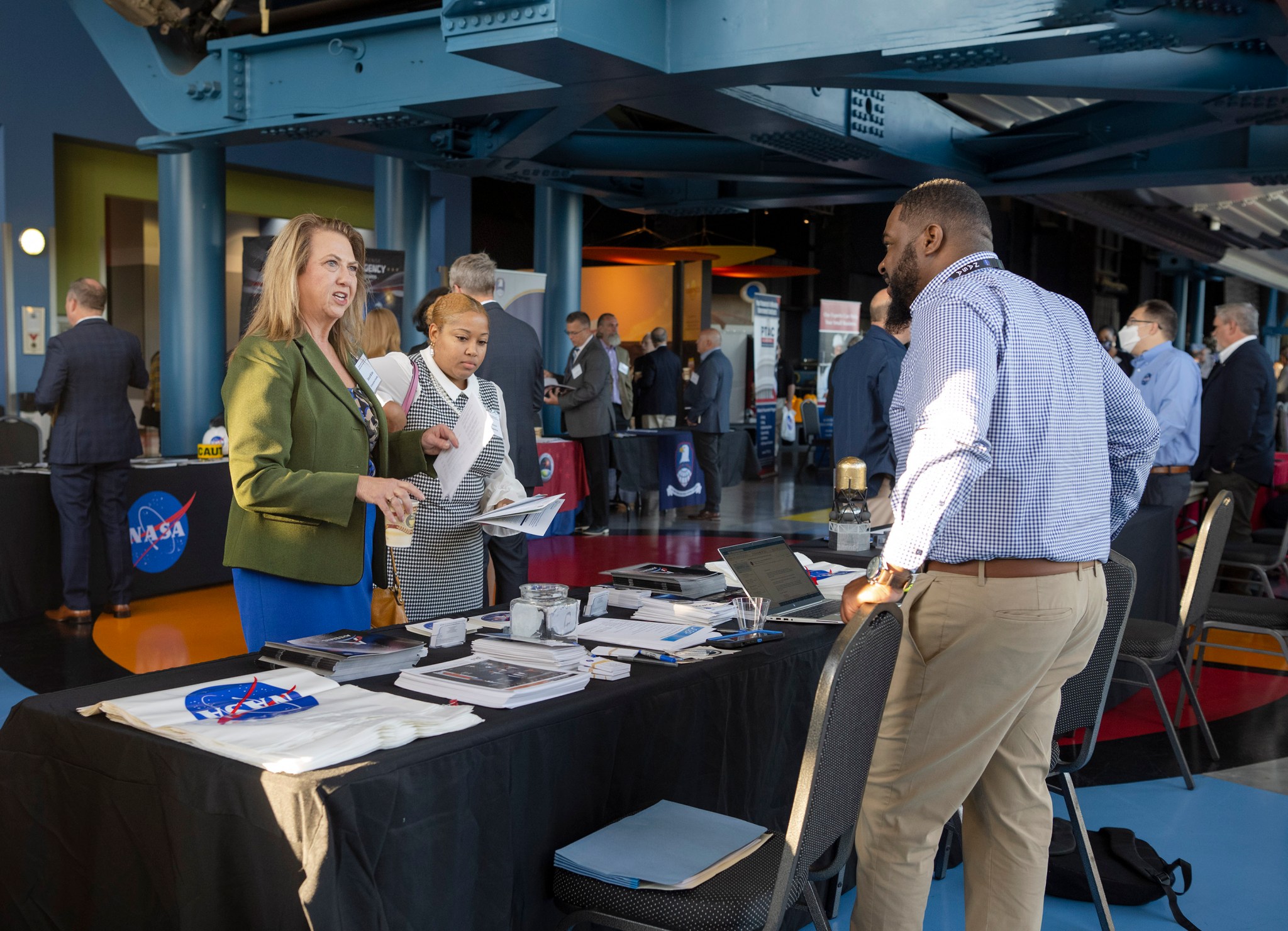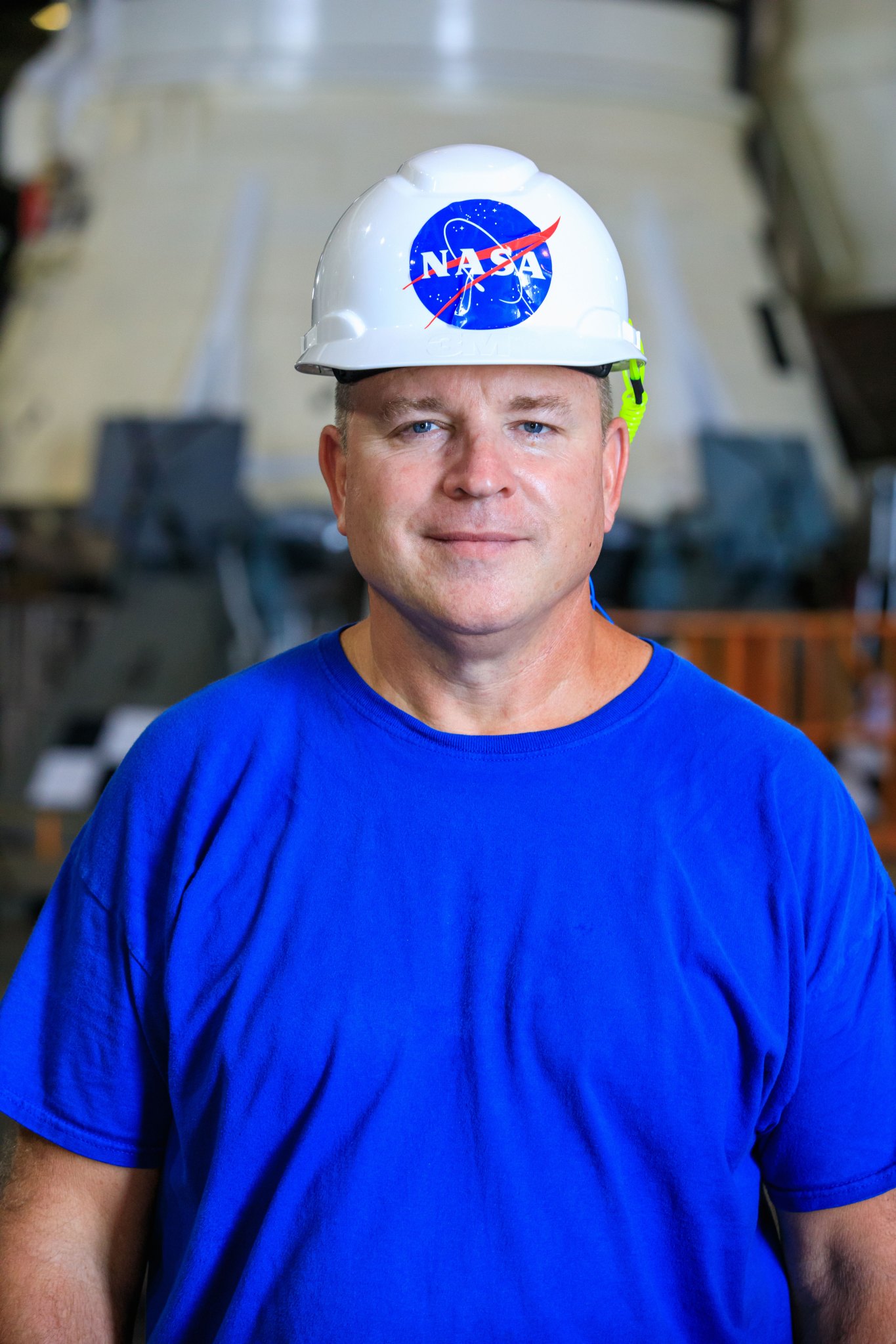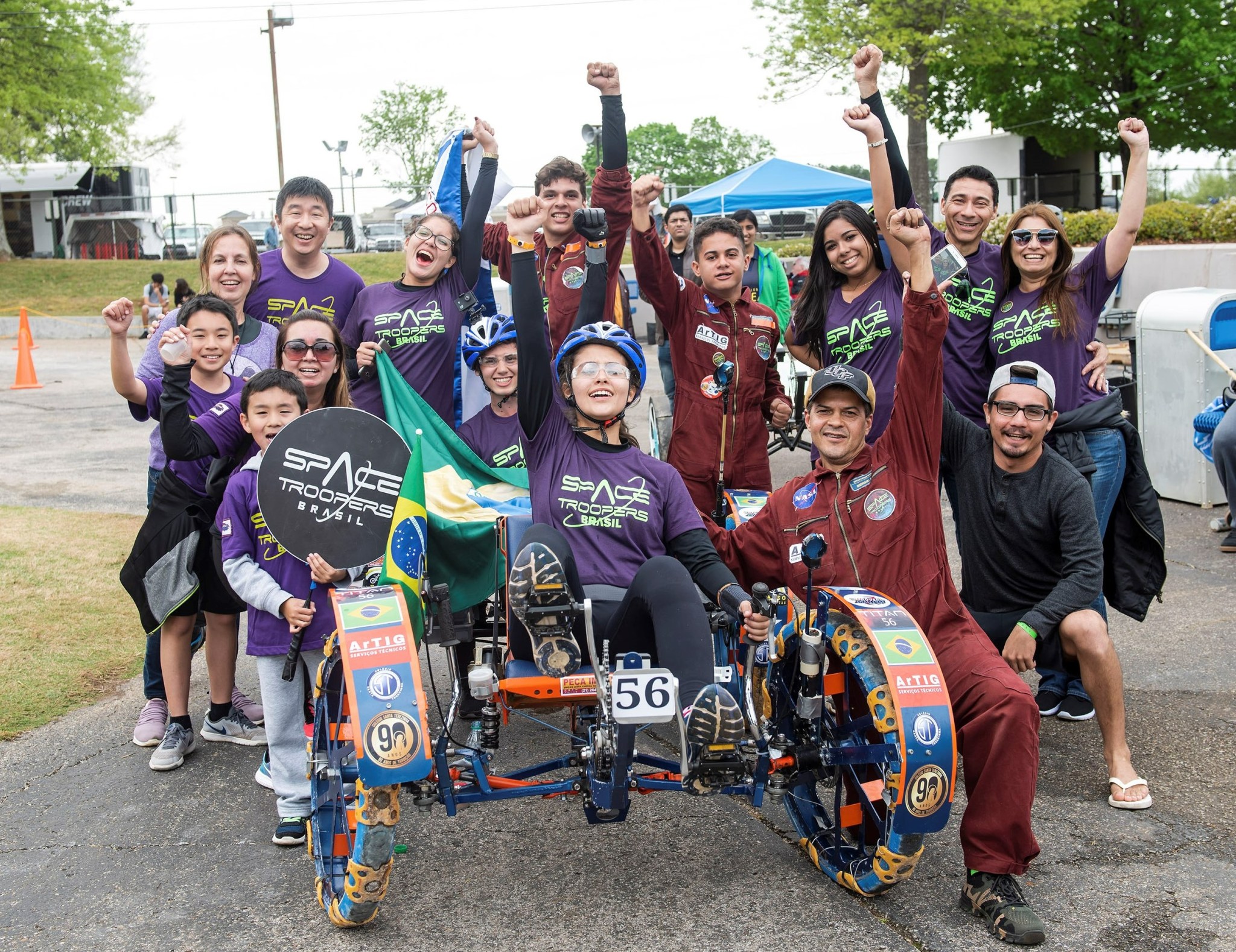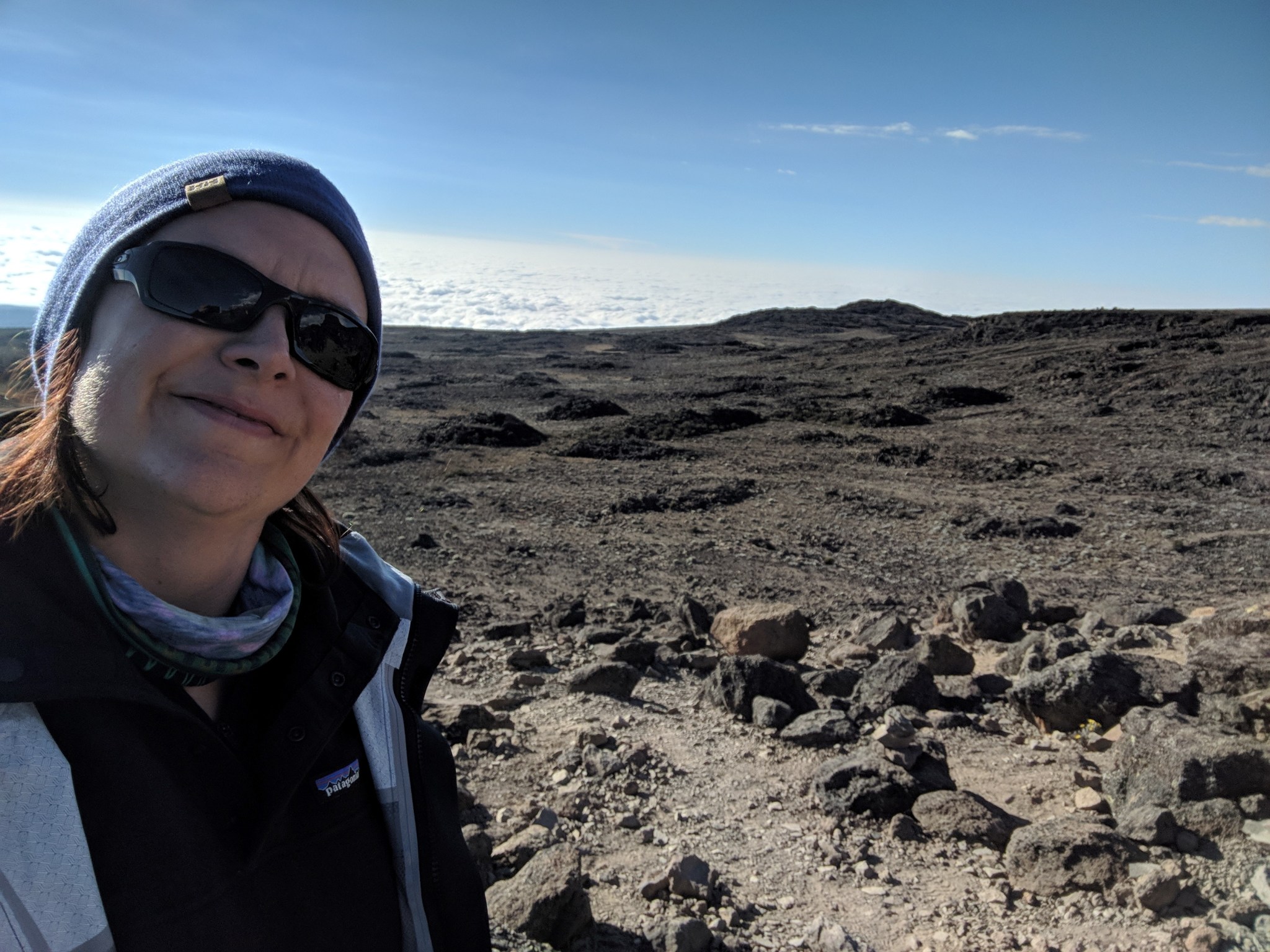In This Week’s Star
- ‘Our Work Lies Beyond the Sky’: Facilities Planners Look to Marshall’s Future
- NASA Sets Date for Next Launch Attempt for Artemis I Moon Mission
- NASA TV to Air Crew Activities as Astronauts Prepare, Return to Earth
- Marshall’s Hispanic Employee Resource Group Builds Community
- NASA Confirms DART Mission Impact Changed Asteroid’s Motion in Space
- Marshall Holds 34th Small Business Alliance Meeting, Presents Industry Awards
- I Am Artemis: Mark Vaccaro
- NASA Selects Teams for 2023 Human Exploration Rover Challenge
- Space Campers Explore a Universe of Touch and Sound with Chandra
- No Mountain Too Tall for Data Scientist Kaylin Bugbee
- NASA’s Chandra Adds X-ray Vision to Webb Images
‘Our Work Lies Beyond the Sky’: Facilities Planners Look to Marshall’s Future
By Rick Smith
NASA’s Marshall Space Flight Center is preparing to say goodbye to a historic facility – one where visionary engineers pioneered the first human missions to the Moon, built a legacy of groundbreaking American space projects and programs for more than 55 years, and put “Rocket City USA” on the map.
Building 4200, Marshall’s administrative headquarters from 1963 until 2020, is scheduled for demolition Oct. 29, helping to make way for a series of new, state-of-the-art facilities tailored to help NASA map out the next century’s worth of discoveries in space.
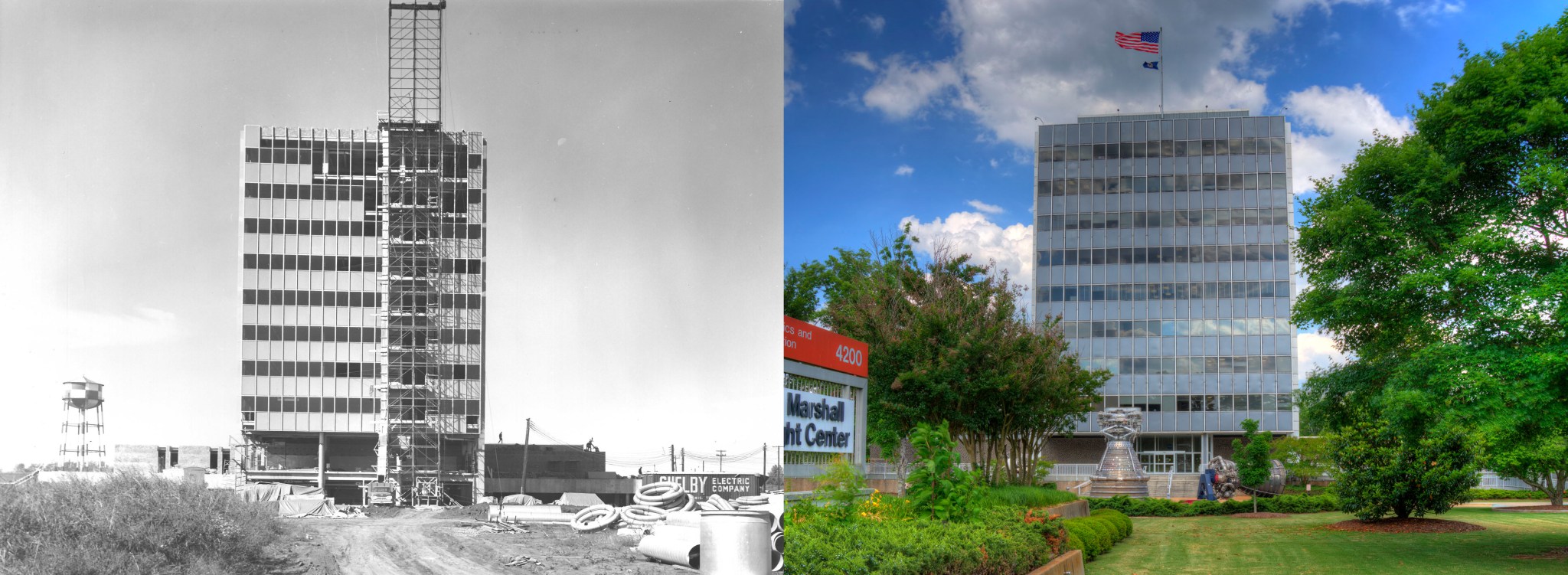
More importantly, say facilities managers at Marshall, the work will make the most efficient use of taxpayer dollars, providing worksites for new generations of engineers, scientists, and support teams.
“Buildings come down, but science and exploration continue onward,” said Marshall Director Jody Singer. “Marshall’s true legacy isn’t a glass and stone edifice, but the men and women who work within – the vanguard of future space frontier expansion for untold decades to come.”
Building 4200 had been in line for an update in 2030 as part of NASA’s “repair-by-replacement” approach – tearing down costly old structures and replacing them with energy-efficient new facilities. But that timeframe was accelerated in 2020, when structural issues were identified in the building’s exterior wall panels. Given its age and the cost of repairing and maintaining it, NASA chose to deactivate and demolish 4200.
That decision tugs a lot of heartstrings here. The building was home to thousands of Marshall team members over much of the past six decades. That number includes 14 directors, from Dr. Wernher von Braun – who led rocket development in the 1960s and 1970s – to Singer, the first woman to serve in the capacity.
Ultimately, though, said Scott Worley, Marshall’s historical preservation officer, NASA’s legacy is what it launches to space, not its humble, Earthbound offices.
“NASA’s legacy isn’t housed in a building,” Worley said. “It’s in the generations of visionary innovators who walk its halls. If we had a choice between renovating an aging building or funding a bold new mission to the outer planets, we’d pick the mission every time. Our work lies beyond the sky.”
Roughly every 10 years, NASA challenges each field center to update its “facilities master plan,” a blueprint for refurbishing or replacing old buildings to effectively do the work of the nation’s space program. Marshall’s master planners helped the center transition from the end of the Space Shuttle Program in 2011 and shape plans for leading development of NASA’s Space Launch System and supporting the International Space Station, NASA’s Commercial Crew Program, and a host of high-value science missions.
Marshall continues to plan for the future, developing the infrastructure and resources to support Moon to Mars exploration – including sending the first woman and first person of color to the Moon, via the Artemis program, and pursuing Human Landing Systems, Habitation Systems, and other advanced technologies and science capabilities they’ll require on the lunar surface.
New buildings must meet rigorous health and safety guidelines in every aspect of construction and operation, including energy costs, water consumption, air quality, and ergonomics. Over the past decade at Marshall, such overhauls have saved up to 65% on facility operating costs and reduced utilities expenses by 35% to 40%.
Ultimately, NASA’s vision for Marshall is a bustling, modern campus atmosphere, loosely centralized around the evolving 4200 complex and its counterpart to the south, the 4600 engineering complex. Greenways between the two hubs will encourage more foot traffic and use of other, non-automotive transportation – another health-conscious move.
The work continues. Building 4200 will be imploded and razed by Target Contractors of Ladson, South Carolina. A second contractor – ARS Aleut Remediation of Oak Ridge, Tennessee – has nearly completed demolition of Building 4201, also in the 4200 complex.
That work will clear the way for new, state-of-the-art buildings in the years ahead, including the Marshall Exploration Facility, a central hub which will house collaborative, support, and administrative spaces, and a sophisticated new Engineering Science Laboratory to replace other 1960s-era engineering, avionics, and optics facilities.
“We’ve spent several years working out what we need and don’t need, tightening up Marshall’s overall square footage,” said Marshall master planner Justin Taylor. “For every square foot we build, we try to take out two square feet – reducing the center’s footprint by as much as half without reducing capability.”
New buildings also will be built to last, even exceeding the 60-year lifespan of some of Marshall’s earliest laboratories and test sites, said facilities project manager Megan Vansant, who is overseeing the demolition efforts for Buildings 4200 and 4201.
“We’re pushing for buildings with century-plus lifespans, easily modifiable floor plans, and utilities and technology access that can be reconfigured or updated as the building evolves and ages,” she said.
Marshall’s historical preservation team is working closely with NASA’s History Office and the Alabama State Historic Preservation Office, in accordance with section 106 of the National Historic Preservation Act, to ensure the history of Building 4200 is preserved. Thousands of photos, videos, and other documents have been archived and made available for public use by the Library of Congress’s Historical American Building Survey and Historical American Engineering Record.
Smith, a Manufacturing Technical Solutions employee, supports Marshall’s Office of Strategic Analysis & Communications.
NASA Sets Date for Next Launch Attempt for Artemis I Moon Mission
NASA is targeting the next launch attempt of the Artemis I mission for Nov. 14 with liftoff of the Space Launch System (SLS) rocket carrying the Orion spacecraft planned during a 69-minute launch window that opens at 12:07 a.m. EST/Nov. 13 at 11:07 p.m. CST. Artemis I is an uncrewed flight test to launch SLS and send Orion around the Moon and back to Earth to thoroughly test its system before flights with astronauts.
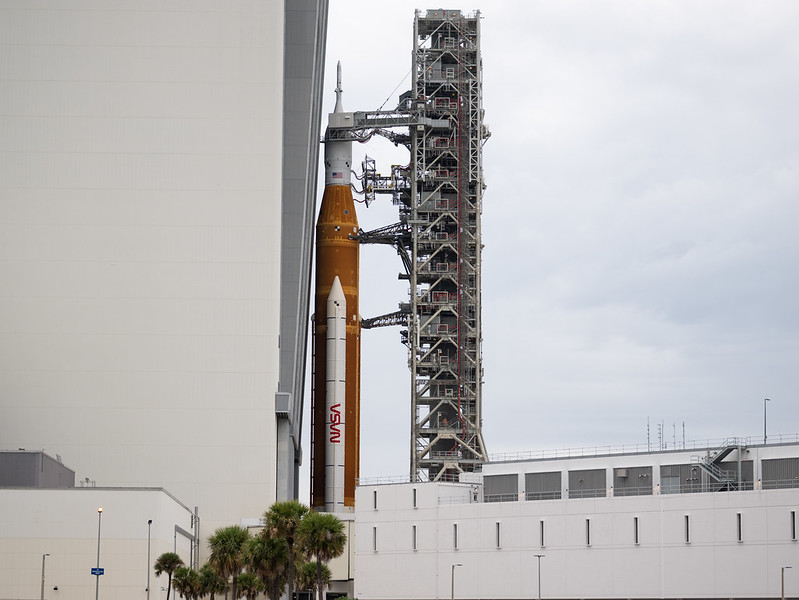
Inspections and analyses over the previous week have confirmed minimal work is required to prepare the rocket and spacecraft to roll out to Launch Pad 39B at Kennedy Space Center following the roll-back due to Hurricane Ian. Teams will perform standard maintenance to repair minor damage to the foam and cork on the thermal protection system and recharge or replace batteries on the rocket, several secondary payloads, and the flight termination system. The agency plans to roll the rocket back to the launch pad as early as Nov. 4.
NASA has requested back-up launch opportunities for Nov. 16, at 1:04 a.m. EST/12:04 a.m. CST and Nov. 19 at 1:45 a.m. EST/12:45 a.m. CST, which are both two-hour launch windows. A launch on Nov. 14 would result in a mission duration of about 25-and-a-half days with a splashdown in the Pacific Ocean on Dec. 9.
NASA TV to Air Crew Activities as Astronauts Prepare, Return to Earth
NASA will provide live coverage of the upcoming return activities for the agency’s SpaceX Crew-4 mission to the International Space Station.
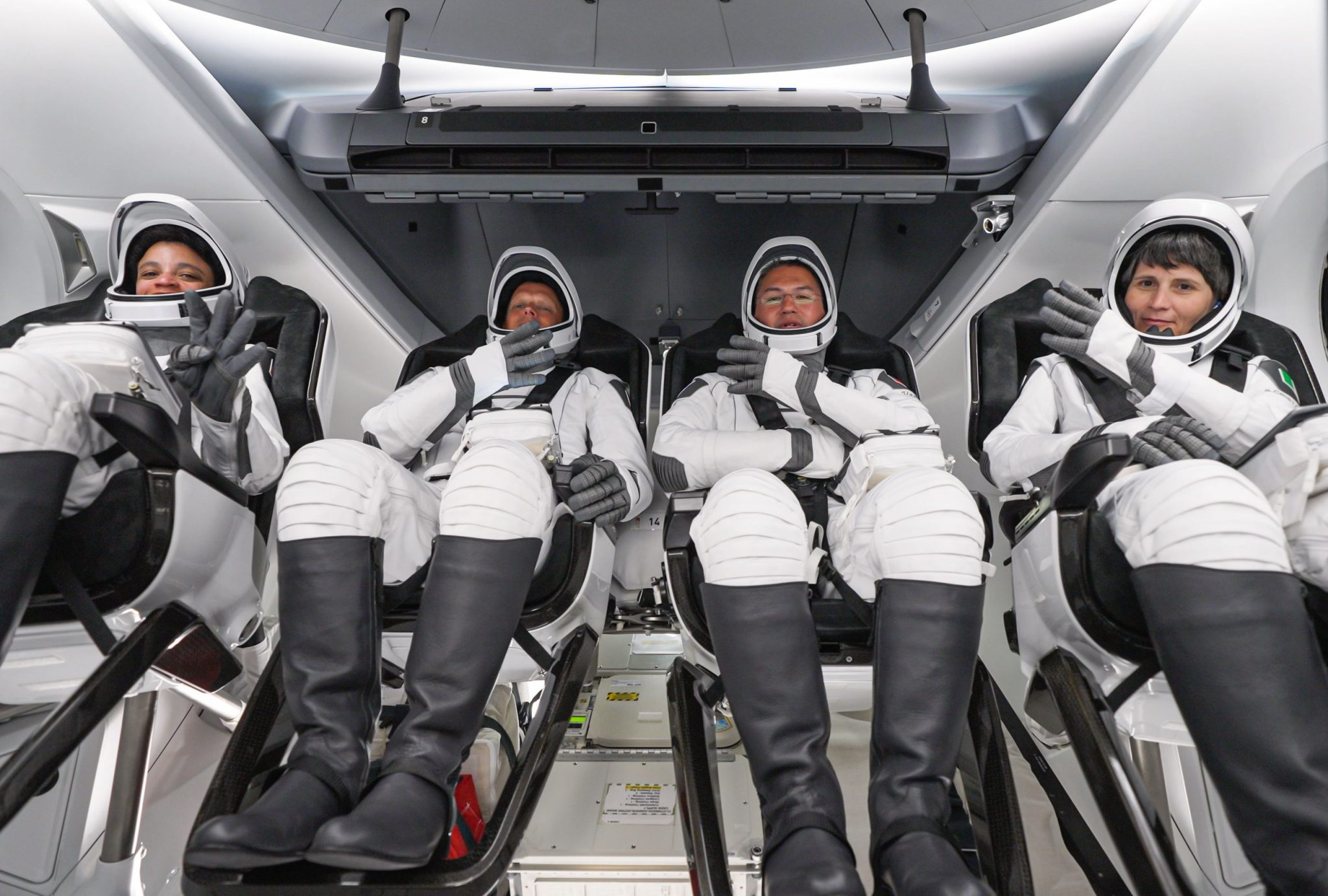
NASA and SpaceX are targeting 4:41 p.m. CDT on Oct. 13, for the splashdown and conclusion of the Crew-4 flight, wrapping up a nearly six-month science mission for NASA astronauts Bob Hines, Kjell Lindgren, and Jessica Watkins, as well as European Space Agency astronaut Samantha Cristoforetti. Their SpaceX Dragon spacecraft is scheduled to undock from the space station at 6:05 p.m. Oct. 12, to begin the journey home.
Weather remains a watch item as teams track the progress of a cold front forecast to pass over the splashdown areas off the Gulf and Atlantic coasts of Florida. Mission teams will continue to monitor splashdown and recovery conditions with another weather review at six hours prior to undocking. Additional undocking opportunities also are available Oct. 13.
The Crew-4 undocking and splashdown coverage will air live on NASA Television, the NASA app, and the agency’s website. NASA also will host an audio only post-splashdown news teleconference.
Marshall’s Hispanic Employee Resource Group Builds Community
By Hannah Maginot
In 2008, Zenia Garcia first came to NASA’s Marshall Space Flight Center as an intern. Nearly 15 years later, she has built not only a thriving career, but a richly supportive community through her involvement in Marshall’s Hispanic Employee Resource Group (ERG).
“Family is such a core part of Hispanic culture,” said Garcia, a formulation manager in Marshall’s Partnerships and Formulation Office. “You find family wherever you go, whether through friends at work or out in the community. We try to make a safe space for each other, through mentorship and community.”
The Hispanic ERG’s mission is to promote the development, inclusion, and innovation of Marshall’s workforce with a focus on employees of Hispanic and Spanish descent. Those goals actively support the NASA Equity Plan, which strives to anchor diversity and equity as a core component of every NASA mission and to identify and remove career barriers that hinder historically underserved and underrepresented communities.
Garcia serves as an ERG board member, along with Marissa Garcia, combustion devices engineer, and Stephanie Ragan, human resources specialist.
For these women, the ERG is a critical resource in reaching the next generation of Hispanic leaders at NASA and in the community. Members participate in outreach events, like last month’s Cultura Festival at the Orion Amphitheater.
The ERG also partners with Huntsville City Schools; they give presentations at Columbia High School, sharing their NASA career stories with students.
“These kids see us, and we look like them. We tell them: ‘If I can do it, so can you,’ and you can tell right away the students are inspired,” Ragan said. “You never know how far that spark might spread.”
This kind of influence is what Marissa Garcia, one of the youngest members of the Hispanic ERG, credits with helping her develop into a proud NASA professional. After relocating to Huntsville from her home in El Paso, Texas, members of the Hispanic ERG warmly welcomed her to Marshall. While she has learned from her senior board members, Marissa Garcia has also brought fresh perspective to the group.
“I want to continue growing the ERG so we are actively recruiting new members,” she said. “I want future generations to have access to this kind of support and community.”
Outside of their official roles, the ERG board members are proud to be a part of the NASA Hispanic community, making Marshall a stronger, safer space for all. For Ragan, this looks like calling out cultural and racial microaggressions when they happen. For Marissa Garcia, requesting team members correctly spell and pronounce names is a powerful way of demonstrating cultural autonomy. Zenia Garcia insists on supporting events sponsored by other ERGs across Marshall, while encouraging them to also show up during Hispanic Heritage Month. The theme of this year’s observance is “Unidos: Inclusivity for a Stronger Nation.”
“Sharing our culture is ingrained in us,” Zenia Garcia said. “We can tie that back to one of the core values of NASA, which is inclusion. United we’re promoting all of this; we can’t do it alone.”
In addition to the Hispanic ERG, Marshall supports a variety of employee resource groups. Team members also are encouraged to check out the monthly “Talk Equity, Diversity, & Inclusion” newsletter on Inside Marshall.
Maginot, a Media Fusion employee, supports Marshall’s Office of Strategic Analysis & Communications.
NASA Confirms DART Mission Impact Changed Asteroid’s Motion in Space
Analysis of data obtained over the past two weeks by NASA’s Double Asteroid Redirection Test (DART) investigation team shows the spacecraft’s kinetic impact with its target asteroid, Dimorphos, successfully altered the asteroid’s orbit. This marks humanity’s first time purposely changing the motion of a celestial object and the first full-scale demonstration of asteroid deflection technology.
“All of us have a responsibility to protect our home planet. After all, it’s the only one we have,” said NASA Administrator Bill Nelson. “This mission shows that NASA is trying to be ready for whatever the universe throws at us. NASA has proven we are serious as a defender of the planet. This is a watershed moment for planetary defense and all of humanity, demonstrating commitment from NASA’s exceptional team and partners from around the world.”
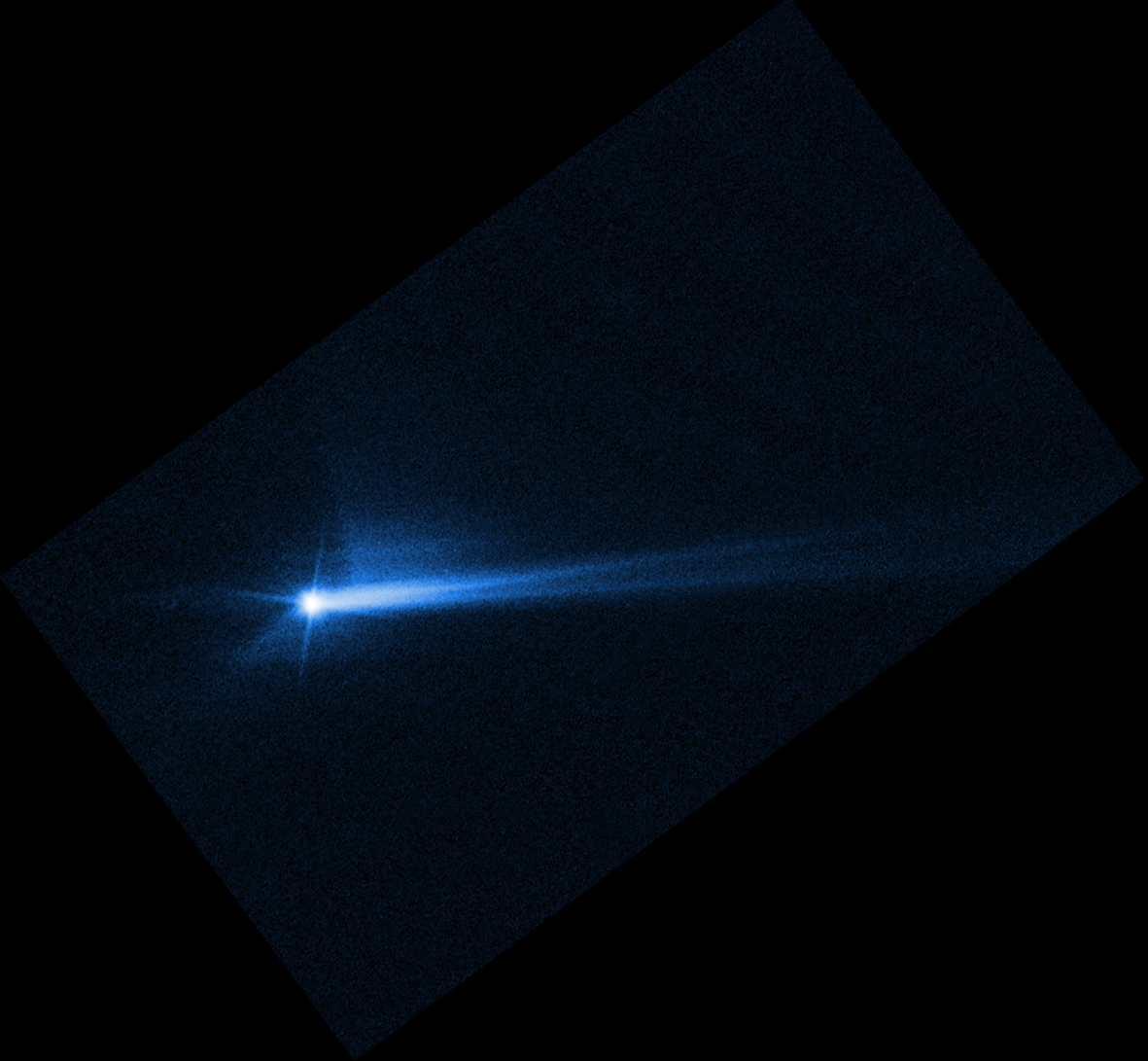
Prior to DART’s impact, it took Dimorphos 11 hours and 55 minutes to orbit its larger parent asteroid, Didymos. Since DART’s intentional collision with Dimorphos on Sept. 26, astronomers have been using telescopes on Earth to measure how much that time has changed. Now, the investigation team has confirmed the spacecraft’s impact altered Dimorphos’ orbit around Didymos by 32 minutes, shortening the 11 hour and 55-minute orbit to 11 hours and 23 minutes. This measurement has a margin of uncertainty of approximately plus or minus 2 minutes.
Before its encounter, NASA had defined a minimum successful orbit period change of Dimorphos as change of 73 seconds or more. This early data show DART surpassed this minimum benchmark by more than 25 times.
“This result is one important step toward understanding the full effect of DART’s impact with its target asteroid,” said Lori Glaze, director of NASA’s Planetary Science Division at NASA Headquarters. “As new data come in each day, astronomers will be able to better assess whether, and how, a mission like DART could be used in the future to help protect Earth from a collision with an asteroid if we ever discover one headed our way.”
The investigation team is still acquiring data with ground-based observatories around the world – as well as with radar facilities at NASA Jet Propulsion Laboratory’s Goldstone planetary radar in California and the National Science Foundation’s Green Bank Observatory in West Virginia. They are updating the period measurement with frequent observations to improve its precision.
Focus now is shifting toward measuring the efficiency of momentum transfer from DART’s roughly 14,000-mile per hour collision with its target. This includes further analysis of the “ejecta” – the many tons of asteroidal rock displaced and launched into space by the impact. The recoil from this blast of debris substantially enhanced DART’s push against Dimorphos – a little like a jet of air streaming out of a balloon sends the balloon in the opposite direction.
To successfully understand the effect of the recoil from the ejecta, more information on of the asteroid’s physical properties, such as the characteristics of its surface, and how strong or weak it is, is needed. These issues are still being investigated.
“DART has given us some fascinating data about both asteroid properties and the effectiveness of a kinetic impactor as a planetary defense technology,” said Nancy Chabot, the DART coordination lead from the Johns Hopkins Applied Physics Laboratory (APL). “The DART team is continuing to work on this rich dataset to fully understand this first planetary defense test of asteroid deflection.”
For this analysis, astronomers will continue to study imagery of Dimorphos from DART’s terminal approach and from the Light Italian CubeSat for Imaging of Asteroids (LICIACube), provided by the Italian Space Agency, to approximate the asteroid’s mass and shape. Roughly four years from now, the European Space Agency’s Hera project is also planned to conduct detailed surveys of both Dimorphos and Didymos, with a particular focus on the crater left by DART’s collision and a precise measurement of Dimorphos’ mass.
Johns Hopkins APL built and operated the DART spacecraft and manages the DART mission for NASA’s Planetary Defense Coordination Office as a project of the agency’s Planetary Missions Program Office, which is at NASA’s Marshall Space Flight Center. Telescopic facilities contributing to the observations used by the DART team to determine this result include: Goldstone, Green Bank Observatory, Swope Telescope at the Las Campanas Observatory in Chile, the Danish Telescope at the La Silla Observatory in Chile, and the Las Cumbres Observatory global telescope network facilities in Chile and in South Africa.
Neither Dimorphos nor Didymos poses any hazard to Earth before or after DART’s controlled collision with Dimorphos.
Marshall Holds 34th Small Business Alliance Meeting, Presents Industry Awards
By Lane Figueroa
Large and small business contractors and subcontractors, NASA program leaders, and regional industry representatives gathered Sept. 29 for the 34th Marshall Space Flight Center Small Business Alliance meeting and 16th annual Industry and Advocates Award Ceremony. Hosted by Marshall at the Davidson Center for Space Exploration in Huntsville, the event featured key NASA program updates and information on policy, oversight, and optimization of procurement resources to enable collaboration between small businesses and NASA. The event was held in person for the first time since February 2020.
“It’s very exciting to be back in person after two years of virtual meetings,” said David Brock, small business specialist at Marshall. “This is one of the best agendas we’ve had for this event, and the future holds multiple opportunities for small companies to get involved with work across NASA centers.”
In addition to remarks from the mayors of Huntsville, Madison, and Decatur, several key NASA programs provided updates on current projects, including the Exploration Production and Operations Contract, Human Landing System Program (HLS), Marshall Logistics Support Services, and Protective Services. Small business office representatives from a number of NASA centers also presented statistics on their collaboration with small companies in fiscal year 2022 and provided valuable information on their center’s specific work.
Dr. Don Krupp, associate manager of the HLS program, provided an overview of lunar lander contracts in development, and highlighted opportunities to contribute to lunar surface technologies such as terrain vehicles, rovers, power sources, and habitats.
“The HLS Program is leaning forward in partnering with industry to ensure the experience, skills, and capabilities of NASA can be applied to the speed and innovation of commercial partners,” said Krupp. “This model has proven to work over the last couple of years.”
The Marshall Small Business Alliance was created to provide industry with maximum exposure to the Marshall marketplace. This meeting was held in conjunction with the NASA Office of Procurement, which oversees the acquisition process to support the successful accomplishments of the agency’s current and future missions.
Following the presentations, Marshall presented the 16th annual Industry and Advocates Awards. The awards reflect leadership in the aerospace business community and sustained achievement in service to Marshall and to NASA’s overarching mission.
The 2022 award recipients are:
Procurement Team of the Year:
- Brian Speer
- Brannon McDowell
Program Team of the Year:
- Shannon Fullenwider
- Thad Stripling
Technical Person of the Year: Paul Johnson
Small Business Technical Advisor of the Year: Clyde S. Jones
Large Business Prime Contractor of the Year: Jacobs
Small Business Prime Contractor of the Year: Acuity Edge, Inc.
Small Business Prime Contractor Excellence Award:
- Aerie Aerospace LLC
- Bastion Technologies, Inc.
- Victory Solutions, Inc.
Small Business Subcontractor of the Year: Arcata Associates, Inc.
Small Business Subcontractor Excellence Award:
- Davis Strategic Innovations
- JBS Solutions, Inc.
- Martinez and Turick, Inc.
- Quadrus Corporation
- Seabrook Solutions LLC
- Vetpowered LLC
Mentor-Protégé Agreement of the Year:
- The Boeing Company
- Southern University
Small Business Leadership Award:
- Kerry Webb
- Lee Ann Hunt
Figueroa, a Media Fusion employee, supports Marshall’s Office of Strategic Analysis & Communications.
I Am Artemis: Mark Vaccaro
For many NASA employees, playing a role in space exploration fuels their passion for the work they do. For Mark Vaccaro, that passion comes from seeing structures and components come together to become new, powerful machines.
“I’m interested in the machines that create machines – the mills, the lathes, and all of the equipment that it takes to build something,” Vaccaro said. “I’ve always enjoyed the idea of building and creating.”
As manager of the structures and assembly team for the Space Launch System (SLS) solid rocket boosters, Vaccaro oversees the integration of the boosters with SLS, the most powerful rocket NASA has ever built. He has helped get booster hardware ready for the Artemis I launch at NASA’s Kennedy Space Center. He also leads the teams at Kennedy’s Booster Fabrication Facility where the aft skirt and forward assembly hardware is being prepared for three additional Artemis missions.
NASA recently recognized Vaccaro’s work by awarding him a 2022 Outstanding Leadership Medal. Another reward was getting to see the SLS rocket and Orion spacecraft up close as the stack rolled out of the Vehicle Assembly Building (VAB) for the first time in March.
Seeing the rocket out in the open was wonderful after months of working on the boosters with parts of the rocket obscured by the VAB’s retractable platforms.
“It’s a whole lot bigger than I imagined,” he said. “As we stacked the boosters segment by segment and brought in the core stage, at each of the joins, VAB work platforms go together around the rocket. Once the vehicle started being built above the boosters, we only really got to see 30 feet above us. With all the platforms around it, you can’t really get a sense of the scale. A lot of times something looks big inside a room and you take it outside and you lose that sense of scale. But seeing that rocket roll out, seeing it on the launch pad, it is impressive. It is a massive launch vehicle.”
A Huntsville native, Vaccaro has a degree in mechanical engineering from the University of Alabama in Huntsville. He joined NASA’s Marshall Space Flight Center in 1989; his first job with the agency was monitoring Boeing’s design contract for International Space Station construction. After returning from Operation Desert Storm, where he served in the U.S. Marine Corps, he worked in mechanical systems design for numerous NASA projects, including antennae deployment and tether release systems, telescoping booms, and ground support equipment. In 2005, he joined the Boosters Office, working avionics for space shuttle missions. For the last 20 shuttle missions, he served as deputy chief engineer for boosters.
Vaccaro became subsystem manager for the SLS booster assembly team in 2011, and the team lead for hardware integration in 2018. When he isn’t building boosters for Artemis missions, he builds other things, including furniture created in his home workshop and landscape design for his yard.
NASA Selects Teams for 2023 Human Exploration Rover Challenge
By Hannah Maginot
NASA has announced the 61 teams selected to compete in the 2023 Human Exploration Rover Challenge (HERC) April 20-22 at the U.S. Space & Rocket Center.
For the 2023 season, HERC returns to live, on-site competition for the first time since 2019. Participating teams will represent 45 colleges and universities and 16 high schools from 30 countries around the world.
Throughout the nine-month challenge, each team will attempt to design, build, and test human-powered rovers capable of traversing a challenging half-mile obstacle course that simulates the terrain of the Moon, Mars, or other rocky bodies in our solar system. In addition, students must also design and demonstrate a unique tool capable of completing various mission tasks.
“A hearty congratulations to this year’s selected teams.” said Miranda Fike, senior education specialist at NASA’s Marshall Space Flight Center. “We welcome our return to in-person competition and look forward to seeing each team’s creative solutions throughout the year and how their rovers and task tools perform on the course in April.”
Along with HERC’s return to Huntsville, the 2023 season will feature a new course location, ten obstacles, and five liquid sample retrieval tasks. Two pilots from each team must complete the challenge in eight minutes or less. Teams earn points by successfully completing design reviews, developing a rover meeting all criteria, and completing course obstacles and mission tasks. Winning teams are those that accumulate the highest number of points throughout the project year in each category.
The students must also think like mission planners, selecting tasks to complete along the path to gain the maximum points available. This encourages teams to develop strategies that balance efficiency with speed and simulates real-world conditions astronauts may face completing space missions.
“Our goal is to make real-world connections between student ingenuity and the vital work NASA is doing to return explorers to the Moon and prepare the way for crewed missions to Mars,” said education specialist Catherine Shelton of the Office of STEM Engagement at Marshall.
HERC is managed by NASA’s Southeast Regional Office of STEM Engagement at Marshall. HERC is one of eight Artemis Student Challenges and reflects the goals of NASA’s Artemis Program, which seeks to put the first woman and person of color on the Moon. NASA’s Office of STEM Engagement strives to further the agency’s goal of encouraging students to pursue degrees and careers in the fields of science, technology, engineering, and mathematics.
Maginot, a Media Fusion employee, supports Marshall’s Office of Strategic Analysis & Communications.
Space Campers Explore a Universe of Touch and Sound with Chandra
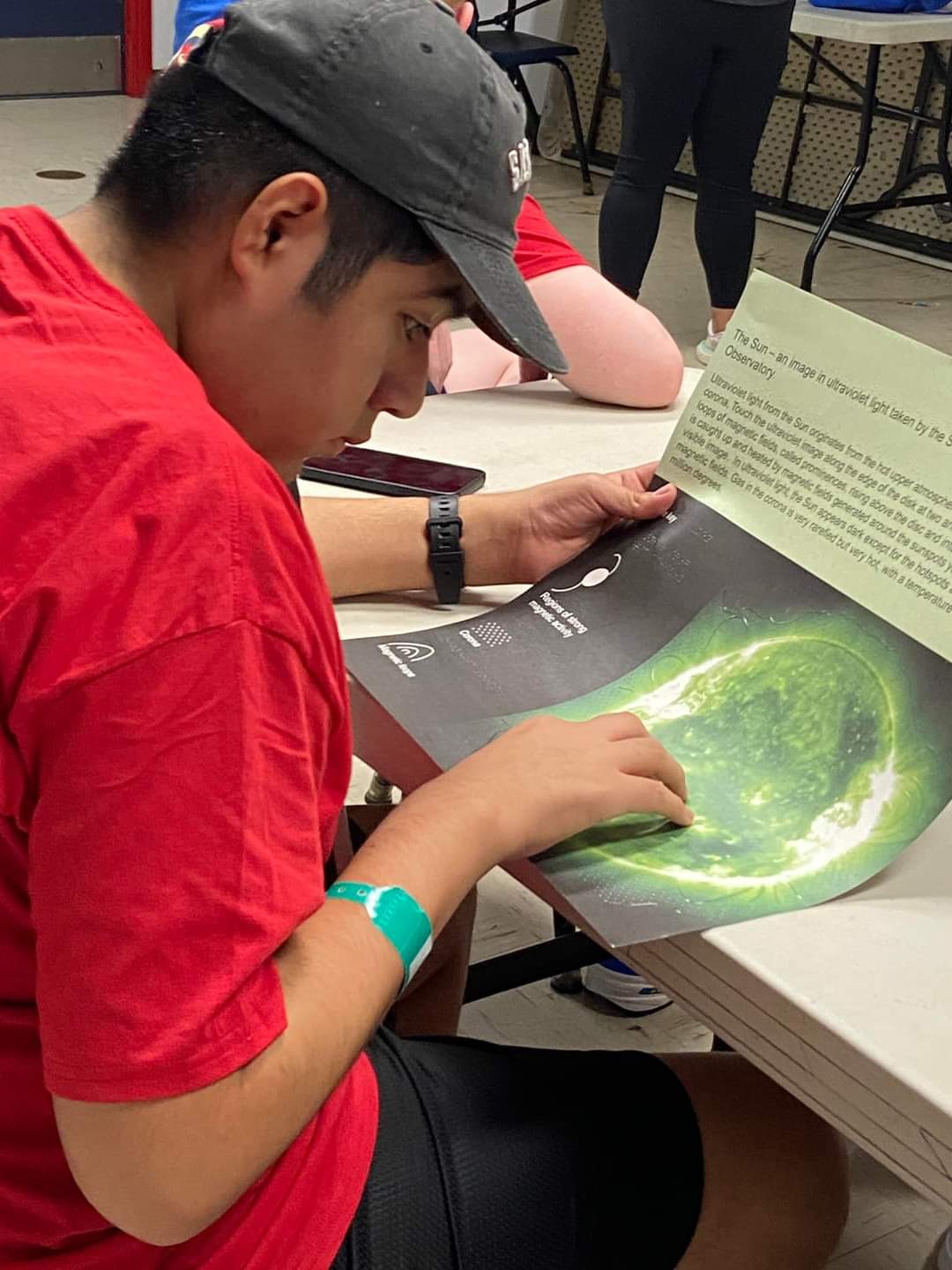
Students experience the wonders of the universe through accessible learning tools from NASA’s Chandra X-ray Observatory at the U.S. Space & Rocket Center’s Space Camp for Interested Visually Impaired Students, or SCIVIS, in September. The Chandra mission engages people who are blind or low vision using a combination of Braille, tactile techniques, audio descriptions of important visual details, data sonifications, and 3D-printed models of celestial objects. NASA’s Marshall Space Flight Center manages the Chandra program. Credits: NASA
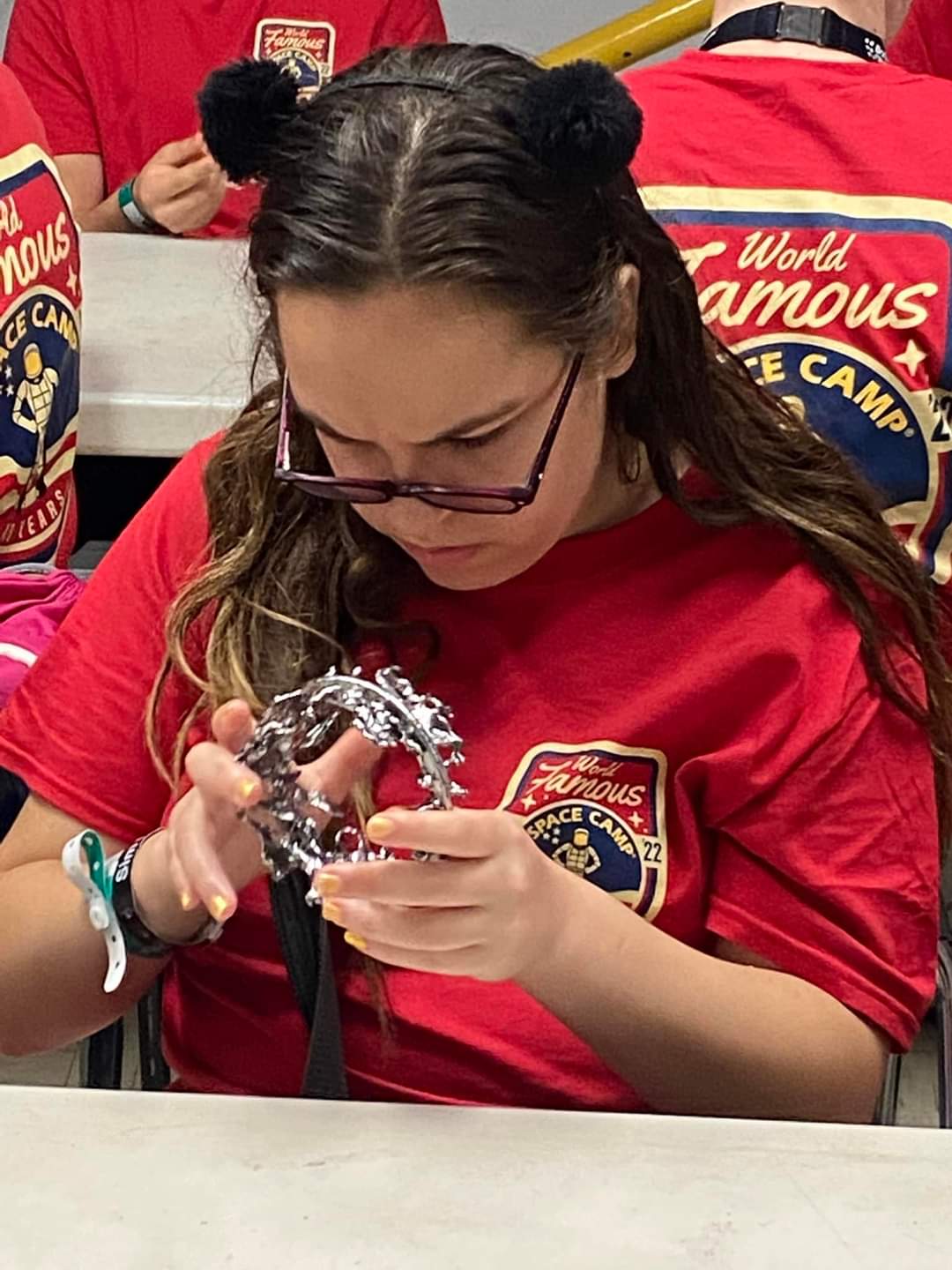
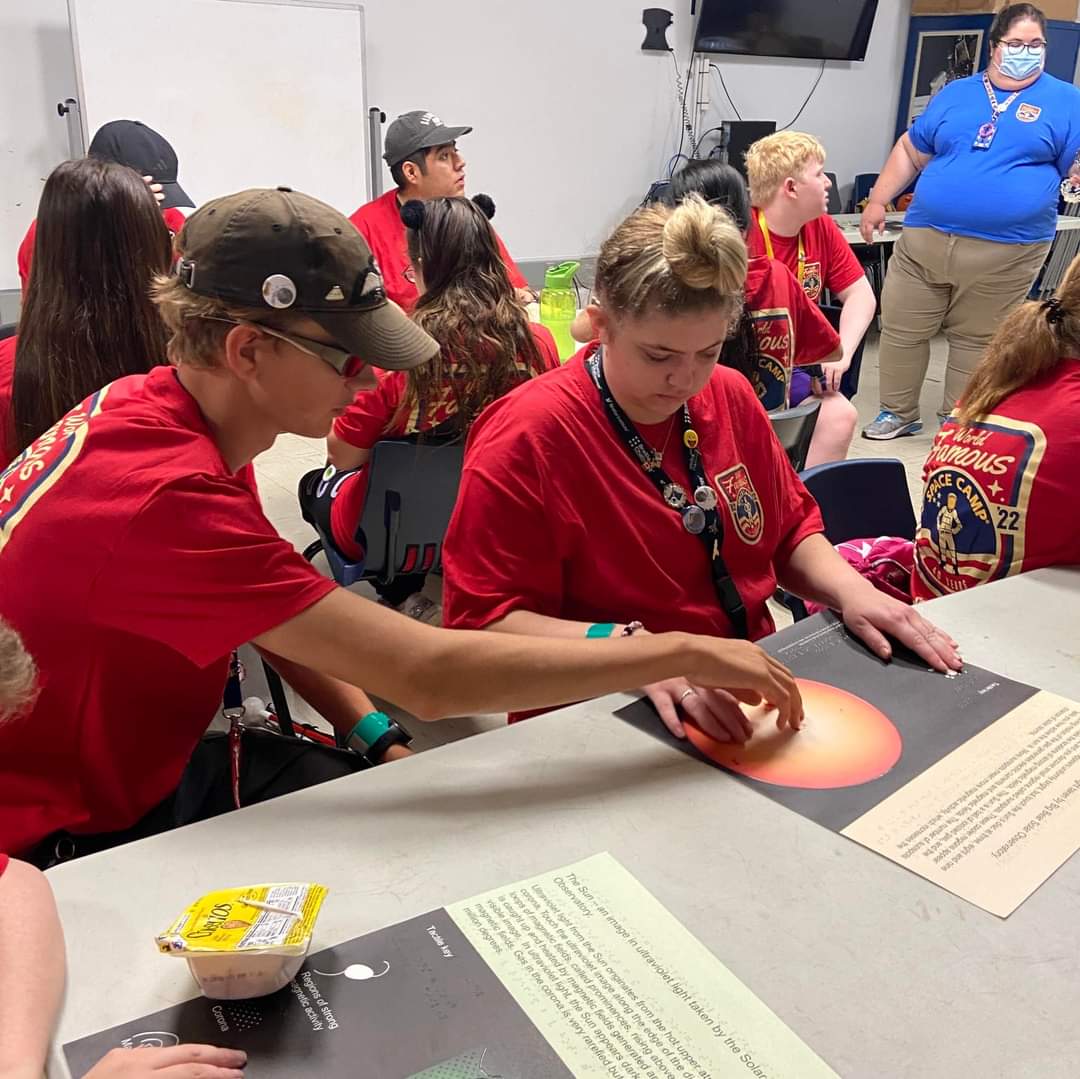
No Mountain Too Tall for Data Scientist Kaylin Bugbee
(This is the fourth in a series of profiles on early career scientists in the Earth Science Branch at NASA’s Marshall Space Flight Center.)
By Dauna Coulter
“I climbed Mount Kilimanjaro in 2018, Mount Fuji in 2019, and hiked the Inca Trail to Machu Picchu in June,” says Kaylin Bugbee, a data scientist at NASA’s Marshall Space Flight Center.
Even when she’s not climbing mountains, she’s climbing mountains – mountains of data, that is.
Every day, an ever-growing number of Earth observation satellites transmit a deluge of images and data to be processed, stored, shared, and studied. NASA planetary science, heliophysics, astrophysics, and biological and physical science missions gather and transmit data, too. Bugbee helps create centralized systems to ensure that scientists, the public, and others around the world can easily locate and access this information.
One project she works on at Marshall is the Science Discovery Engine, which streamlines search and discovery of data and information for the agency’s five science disciplines.
“For this project in the first year we’re collecting the low hanging fruit – the core data located in well-known places and likely to be heavily used,” Bugbee said. “We want to make the first release of the system publicly available by early December with a good solid representation of data and documents for all five disciplines. As people use it and give us feedback, we can improve it, add features, and collect more data.”
The second project she works on at Marshall is the Multi-Mission Algorithm and Analysis Platform, or MAAP. A collaboration between NASA and the European Space Agency (ESA), MAAP provides easy access to both agencies’ Earth science data.
“We’ve released the first version of the MAAP dashboard, focusing on comprehensive mapping of Earth’s forests,” Bugbee said. “Several ESA and NASA Earth observation satellites and instruments are measuring this biomass, and newer, more advanced missions are on tap.”
Bugbee explained this continuous data record from these sensors is key to understanding how biomass is changing on the planet and will throw some light on climate change. They’ve already assembled a huge amount of the data.
There’s another mountain Bugbee has had to climb.
“When I was 35, working full time at the University of Alabama in Huntsville, and earning my master’s in Earth system science, I was diagnosed with cancer,” she said. “I had to have both surgery and chemotherapy.”
She came out on top.
“Soon after being declared cancer-free, I got the NASA job,” said Bugbee. “It was all a dream come true. When I was climbing Kilimanjaro, the Swahili porters would say, ‘pole pole.’ That means ‘slowly, slowly.’ I believe you have to be slow and steady and unwavering in your approach to overcome any challenge you face. And remember – each day is a gift.”
Coulter, a Media Fusion employee, supports Marshall’s Office of Strategic Analysis & Communications.
NASA’s Chandra Adds X-ray Vision to Webb Images
These images are from some of the earliest observations made by Webb.
Chandra had previously observed these objects in X-ray light.
These composites demonstrate how these two telescopes can work together.
More at: https://chandra.si.edu/photo/2022/chandrawebb/ Credits: NASA/CXC/SAO
In the summer of 2022, NASA’s James Webb Space Telescope released images from some of its earliest observations with the newly commissioned telescope. Almost instantaneously, these stunning images landed everywhere from the front pages of news outlets to larger-than-life displays in Times Square. Webb, however, will not pursue its exploration of the universe on its own. It is designed to work in concert with NASA’s many other telescopes as well as facilities both in space and on the ground. These new versions of Webb’s first images combine its infrared data with X-rays collected by NASA’s Chandra X-ray Observatory, underscoring how the power of any of these telescopes is only enhanced when joined with others. NASA’s Marshall Space Flight Center manages the Chandra program. Marshall also contributed to the development of the James Webb Space Telescope, which is managed by Goddard Space Flight Center and launched Christmas Day 2021. Credit: X-ray: NASA/CXC/SAO; IR (Spitzer): NASA/JPL-Caltech; IR (Webb): NASA/ESA/CSA/STScI



























